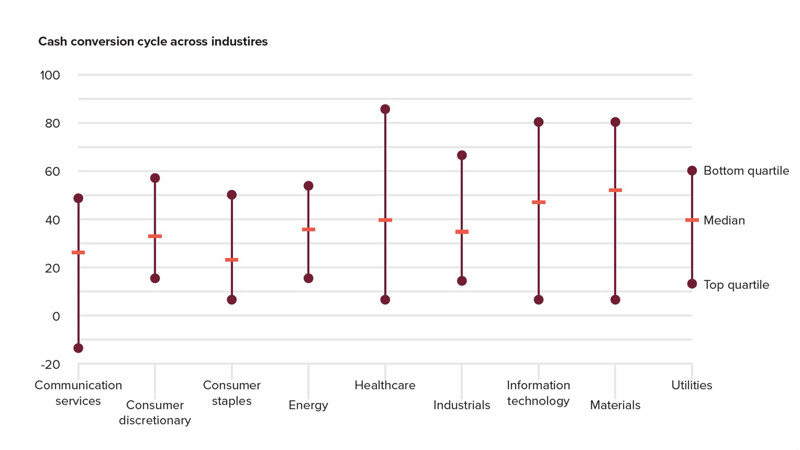How structured is your approach to managing working capital? Do you have a deep understanding of your own figures and the factors that can improve or worsen your liquidity? By continuously working on your working capital, you cannot only ensure strong processes but also create a solid foundation if a crisis hits your company. In uncertain times, working capital becomes a strategic lever for continuity and success – and you can learn more about how to use it best in this article.
Our experience shows that there is significant liquidity potential in optimising internal processes and workflows across your entire value chain. By systematically working on these processes, your company can achieve substantial improvements in cash flow and reduce dependency on external financing sources.
The business value of this is that it can enhance your financial flexibility and create a positive bottom line, for example, through reduced debtor losses and fewer inventory write-downs. Moreover, it prepares you to handle future challenges and seize growth opportunities.
But the be-all and end-all is having a good understanding of your own figures and the actual drivers that release capital – or the opposite.
The liquidity potential is wholly or partially unrealised for most
An analysis of 250 Nordic companies with a turnover of over 2 billion DKK, conducted by McKinsey, shows significant variation across sectors in the extent to which liquidity potential is realised. This variation indicates a substantial potential for improvement – even among companies that already have a good Cash Conversion Cycle (CCC).

Figure 1 shows McKinsey's study of the three elements of the CCC: Days Sales Outstanding (DSO), Days Payable Outstanding (DPO) and Days Inventory Outstanding (DIO), and the results showed nearly the same large variation within individual industries ‒ even among top-quartile companies.
This is striking.
The figure emphasises that even companies with a low CCC have internal processes that can be improved, and it is necessary to delve into the individual elements.
Therefore, it is challenging to realise the full liquidity potential
Even though Figure 1 shows that most companies have significant potential to release a substantial amount of liquidity, it is difficult to realise it.
Working capital optimisation may seem straightforward, but in practice, it often proves to be much more complex to achieve and especially to maintain low working capital. Many companies lack a clear and detailed understanding of how their processes impact working capital, making it difficult to identify the individual elements where improvements can be made.
Moreover, optimising working capital requires changes to existing processes and workflows. This calls for a structured approach, as the processes often involve multiple departments and affect the workflows of several employees.
Flawless invoicing can contribute to healthy working capital management
Are we already convincing you that now is the time to work on your working capital? Then your invoicing is an ideal place to start.
Figure 1 shows that the best-performing companies have errors in less than 4% of all outgoing invoices, while the worst-performing have three times as many errors in their invoicing. These errors result in higher costs and poorer Days Sales Outstanding (DSO), negatively affecting the company's cash flow.
But what should you do to achieve flawless invoicing and thereby improve working capital?
Here, it is crucial to focus on the four key processes: (1) the sales process, (2) credit management, (3) order management and (4) invoicing. By optimising these areas, you can reduce the error rate in invoices, leading to lower costs and better DSO.
Here, we delve into the specific focus areas you can concentrate on within the four key processes:
- Streamline the sales process with a well-designed standard agreement.
An effective sales process begins with a clear contract and agreement foundation. This is crucial for minimising the risk of delivery disputes later on. When all parties agree on the terms from the start, it not only creates clarity but also builds trust. This means that when it comes to invoicing and collection processes, there is a solid agreement foundation to rely on.
We have often found that the time invested in reviewing the company's standard agreements and assessing any deviations in terms of risk, associated costs and complexity is well spent. This careful preparation can save your company many headaches and resources later on. It is about creating a robust framework that both protects the company and promotes a smooth and efficient sales process. - Enhance your responsiveness with credit management following a defined credit policy
Selling to customers with both the ability and willingness to pay is a cornerstone of your company's success. Therefore, it is important to establish a strong credit policy that clearly defines which customers your company wants to do business with and what credit information needs to be obtained.
In times of crisis, developments can occur rapidly, so it is crucial that all customers are continuously assessed according to the established credit policy. Your company must be ready to adapt to changing economic conditions and respond quickly to warning signs. - Create effective order management with clear roles and responsibilities
Once you have made an important sales agreement, it is crucial to execute it quickly and efficiently. Order management plays a central role here. Having a clear plan and precise allocation of roles and responsibilities creates transparency, making the entire order process smoother and more efficient.
Well-defined order management ensures there is no confusion or misunderstandings along the way. All parties involved know exactly what is expected of them and how they should contribute to executing the order. This not only increases efficiency but also builds trust among team members, which is crucial for the successful execution of the sales agreement. - Place invoicing as close to delivery as possible
Invoicing is not just about sending a bill; it is a necessary part of your company's cash flow, and therefore the process must be as efficient as possible.
The good thing about invoicing is that it often only requires optimisation of internal processes. By invoicing as early as possible after delivery and ensuring a close timing between delivery and invoicing, you can reduce delays and improve liquidity. Experience shows that there are often two to three days to gain in this area, which can make a significant difference to a company's finances.
A structured effort pays off
Even if you already know your drivers for working capital, the potential of a structured and focused effort, even over shorter periods, is often much greater than expected.
With the current interest rates, there is an obvious business case for optimising working capital. However, the greatest financial gain is often hidden elsewhere, such as:
- Fewer write-downs on receivables and improved customer dialogues
- Fewer inventory write-downs, as well as better purchasing and collaboration between procurement and sales
- More professional dialogue with suppliers, as many companies still pay a significant portion of their supplier invoices too early.
It is important to emphasise that the finance department cannot solve these challenges alone.
The business must be involved, as they often "own" the processes. By involving the entire organisation and focusing on the hidden gains in working capital, you can achieve significant improvements in both liquidity and financial performance. A structured approach to working capital optimisation is therefore not only a necessity but also a highly strategic advantage for you.

Would you like to put working capital higher on the agenda?
You are welcome to contact Senior Partner Casper Oxlund-Mariegaard who can unlock the significant liquidity potential hidden in your internal processes and working capital. We would also like to demonstrate how much insight you can gain from an initial data analysis and a one-day workshop.

 en
en
 da
da



